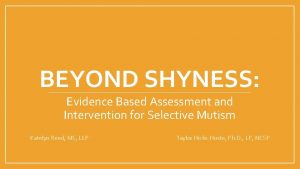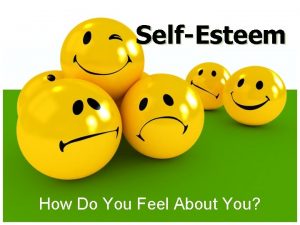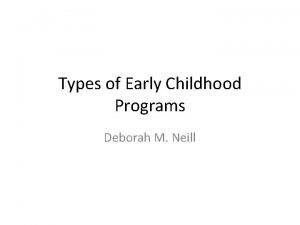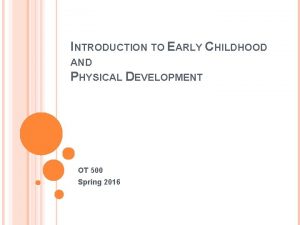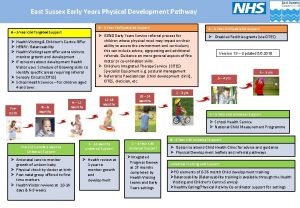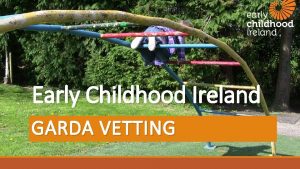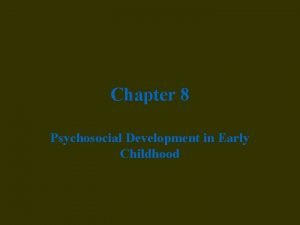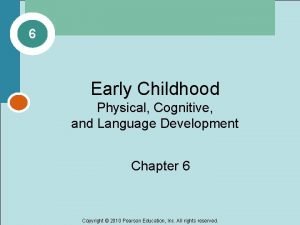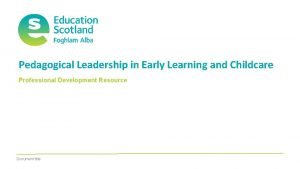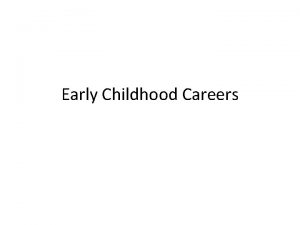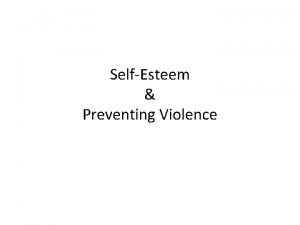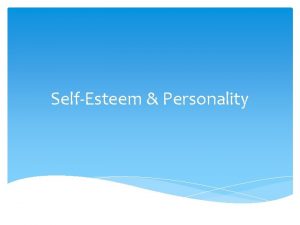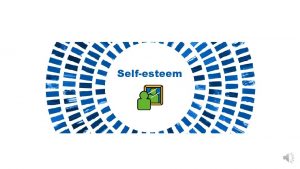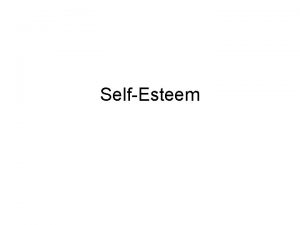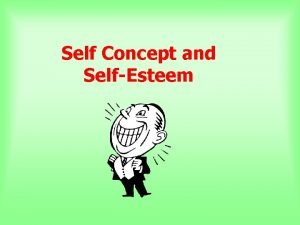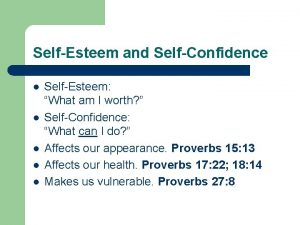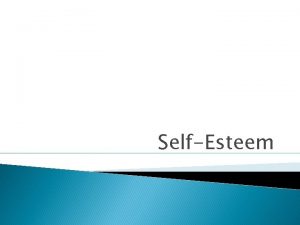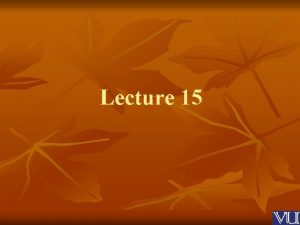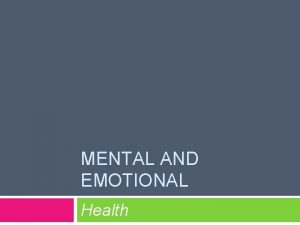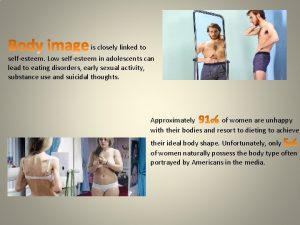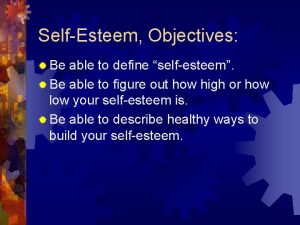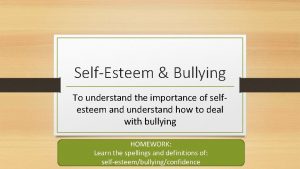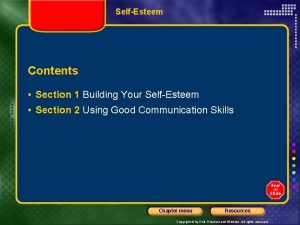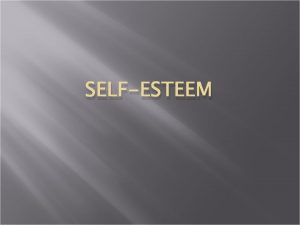Shyness and SelfEsteem in Early Childhood Empowering Young

































- Slides: 33

Shyness and Self-Esteem in Early Childhood Empowering Young Children For Success in School and in Life

Have You Ever Heard A Child Say? . . . • • “I can’t do it!” “I am stupid!” “I am not good enough!” “I don’t know!”

So Have I • These are just four of the many negative comments I heard children say to themselves as they were approaching slightly challenging learning situations in our urban schools. • Although we have established a caring community of learners based on the Responsive Classroom model and focused on children’s social/emotional development besides ensuring their academic success; I felt that something needs to be done to help children believe in themselves and their ability to succeed in certain tasks. (Szente, 2007)

Terms to Know • Self-efficacy: the expectation that one can successfully carry out a behavior to produce a desired outcome; making things happen • Self-esteem: a person’s overall evaluation and appraisal of his or her own worth • Shyness: anxiety and behavioral inhibition in social situations (Leary, 1986)

Did You Know? • There are parallels between a lack of motivation towards learning and low selfesteem. (Szente, 2007) • Most people experience occasional shyness. Feelings of anxiety and consequent behavioral inhibition are not uncommon, but can have an effect on an individual’s emotional and social well-being (Zimbardo, 1977)

Did You Know? • The majority of theoretical and empirical investigations of shyness have focused on adult shyness. • Child shyness has become a recent interest of study. (Asendorpf, 1986)

So What’s the Purpose? • The two purposes of this study are to explore the links between self-esteem and shyness in 4 -year-old children, and use a self-esteem measure designed to gain an understanding of the preschool child’s understanding of self.

The Link: Shyness and Self-Esteem • Several studies implicate low self-esteem as a component of shyness. • Crozier (1981) suggested that the low selfesteem of shy persons leads them to enter social situations fearing that they will lack the social competence to perform appropriately, and that they will be negatively evaluated by others.

The Link: Shyness and Self-Esteem • Others have suggested that shy persons suffer from low self-efficacy, an important dimension of selfesteem (Campbell & Fairey et. , 1985) • Persons having low self-efficacy may understand behavioral norms for a situation, yet believe they are incompetent to act in the manner required by the situation.

The Link: Shyness and Self-Esteem • They expect to fail if they attempt to produce the required behaviors (Bandura, et. , 1977) – Teacher: “Rashid, please turn around and finish your class assignment. Math is your favorite subject. ” – Rashid: “I don’t want to turn around or do this stupid math. ”

What do the Researchers Say? • The causes of shyness have not been demonstrated adequately to justify any firm statements on the issue. • Possible causes: – Genes predisposing a person to shyness, – A less than firm attachment bond between parent and child – Poor acquisition of social skills – Parents, siblings, or others harshly and frequently teasing or criticizing a child (Asendorpf, 1993; Sanson, Pedlam, Cann, Prior, & Oberklaid, 1996)

Connections: Shyness + Self-Esteem + Preschoolers • Asendorpf (1987) provided some evidence suggesting that shy 3 -and 4 -year-olds are more likely to yield and give in to conflict, are less assertive, are less resourceful in initiating activities, are more likely to use “wait-andhover” tactics when entering play, are less direct in expressing feelings, and are less energetic and lively than their less shy peers.

Connections: Shyness + Self-Esteem + Preschoolers • Zimbardo and Radl (1981) reported that, according to teacher ratings, shy preschoolers are more timid regarding taking physical risks, are more likely to sit and watch than to play vigorously, are less self-directed, and are less likely to act as leaders than are less-shy children. • Taken together, these characteristics may be interpreted as reflecting a limited sense of selfconfidence and efficacy

Connections: Shyness + Self-Esteem + Preschoolers • Bandura (1977, 1981) suggested that perhaps no aspect of self-knowledge is more central to individuals’ day-to-day lives than the conception of their personal efficacy

Connections: Shyness + Self-Esteem + Preschoolers • According to the Piagetian theory, children younger than approximately age 7, make little use of social comparison when making selfevaluations; rather, they make evaluations based on an absolute standard (Ruble, et. Al. , 1980)

Connections: Shyness + Self-Esteem + Preschoolers • Early shyness is an important area for investigation because the evidence suggests that shyness shows moderate long-term stability (Asendorpf, 1990) • It is associated with interpersonal difficulties across development

Connections: Shyness + Self-Esteem + Preschoolers • Gresham, Elliott, and Evans-Fernandez (1993) characterize self-esteem as a construct which includes ‘‘self-evaluation of competence in certain domains of functioning (e. g. , academic, social, or vocational success). ’’ • This research suggests that students who demonstrate high levels of positive self-belief in their competencies, in both academic and nonacademic contexts, tend to have higher selfesteem when compared to their lower scoring peers.

Connections: Shyness + Self-Esteem + Preschoolers • The construct of self-esteem also includes self perceptions about certain attributes that are valued by a given culture or society. These include ‘‘physical attractiveness, sense of humor, or pleasing personality’’ (Gresham, Elliott, & Evans-Fernandez, 1993). • As this description implies, children who believe that they are physically attractive or humorous, have higher self-esteem than their peers who do not believe they possess these culturally valued attributes.

Connections: Shyness + Self-Esteem + Preschoolers • Further, Coopersmith (1981) states that ‘‘persons with high-self esteem are also more likely to assume an active role in social groups and to express their views frequently and effectively. ’’ • Coopersmith (1981, p. 5) also viewed people with high self-esteem as ‘‘less troubled by fears and ambivalence’’ and more likely to resist pressures or negative stimuli.

Connections: Shyness + Self-Esteem + Preschoolers • Self-efficacy on the other hand reflects how confident individuals are in their ability to perform certain tasks (Gresham, Elliott, & Evans-Fernandez, 1993). • Within the social-cognitive theoretical framework Bandura (1986) suggests that people are able to control their thoughts, actions and feelings through a specific selfsystem.

Connections: Shyness + Self-Esteem + Preschoolers • This self-system allows people to consciously make decisions, take actions, and have more control over their lives. • Pajares (1997) found that peoples behavior can be reliably predicted by ‘‘their beliefs about their capabilities. ’’ • For example, a child with positive self-beliefs tends to have more successful and positive experiences throughout life. • Children with higher self-efficacy seem to be more successful academically as well (Margolis & Mc. Cabe, 2003).

Connections: Shyness + Self-Esteem + Preschoolers • It is important to remember, however, that individuals at times cannot achieve goals that are outside their competencies. • In other words, just by believing you can do something does not mean you actually can. • A kindergarten child, for example, cannot become a high-school football star simply by believing that s/he can suddenly become older and attend high-school.

Connections: Shyness + Self-Esteem + Preschoolers • What matters instead are peoples own perceptions about what they can do ‘‘with the knowledge and skills they have’’ (Pajares, 1997) • The same child, on the other hand, could become a high-school football star with adequate training, practice, and experience besides a strong belief in his/her ability to succeed.

Connections: Shyness + Self-Esteem + Preschoolers • In addition, self-efficacy beliefs not only influence the choices we make, but also influence the time we spend on achieving our goals. • According to Pajares (1997), beliefs of competence or lack of competence ‘‘help determine how much effort people will expend on an activity, how long they will persevere when confronting obstacles, and how resilient they will prove in the face of adverse situations. ’’

Connections: Shyness + Self-Esteem + Preschoolers • The lower a child's self-efficacy is the less time the child would spend on academics and over time the child may even create a ‘‘self-fulfilling prophecies of failure’’ (Margolis & Mc. Cabe, 2006, p. 220).

Methods • The participants are 16 children, 5 boys and 11 girls, drawn from one pre-kindergarten class of three and four year olds at Ross Elementary School. • Parents of the children were mainly professionals • Of the participants, 4 children are Black, 4 are Hispanic, 1 is Asian, 2 are White

Methods • Data for the full sample of children are collected using the following measures of selfesteem: – A self-efficacy interview will be conducted with each child. – Teacher ratings of each child’s self-esteem will be obtained at the end of the data collection period – A shy behavior questionnaire will be completed by the teacher for each child

Methods • The self-efficacy interview will focus on the child’s expectations of self-efficacy regarding physical activities. – The interview items are based on fine gross motor skills typical of the average 4 -year old child (Brigance, 1978) – A trial question was administered to ascertain that the child understood that he or she would not be asked to demonstrate

Methods • Test items included: – “Can you stand on one foot, like this? ” – “Here is a drawing of a square. Do you think you could copy that square on another piece of paper? ” • Teacher self-esteem rating – Will consist of a 5 -item questionnaire. – Teacher’s will be asked to rate the child’s self-esteem on a scale of 1 to 5. – Self-esteem will be broadly defined as “feelings of self -worth and competence”

Methods • Shy behavior questionnaire – Will be completed by teacher – Teacher will compare child with others his or her age on characteristics such as bashfulness, assertiveness, self-directedness, and independence – Example: Compared with other children of his or her age, does child become embarrassed more easily, less easily, or about as easily?

HOPE: Implications for Teachers and Parents • Research indicates that children with lower self-efficacy have more difficulty with academics (Margolis & Mc. Cabe, 2003) and also struggling learners have lower selfefficacy for the academics.

HOPE: Implications for Teachers and Parents • As Mc. Cabe (2003, p. 13) suggested ‘‘self-efficacy is an important influence on motivation. ’’ • The more children believe in themselves and in their abilities to be successful, the more they persevere and keep on trying to achieve their set goals. • More positive experiences result in the desire for further success, which will contribute to a goal and ‘‘I can’’ oriented life in the future.

HOPE: Implications for Teachers and Parents • Such orientation will enable children to also be more successful in the world of work later on in their lives. • Once both educators and families start applying these powerful self-motivating strategies at the same time, it is anticipated that fewer and fewer children will express comments like the ones that opened this presentation.
 Beyond shyness
Beyond shyness Infancy early childhood middle childhood adolescence
Infancy early childhood middle childhood adolescence Self esteem definition
Self esteem definition Selfesteem definition
Selfesteem definition Professional development rockefeller college
Professional development rockefeller college Early childhood education and care directorate
Early childhood education and care directorate Schoenbaum family center
Schoenbaum family center Empowering and delegating
Empowering and delegating Purpose of delegation
Purpose of delegation Three types of early childhood programs
Three types of early childhood programs Types of early childhood programs activity a chapter 2
Types of early childhood programs activity a chapter 2 Efq element 1
Efq element 1 Early childhood framework for quality
Early childhood framework for quality How to welcome parents in orientation
How to welcome parents in orientation Leonardo da vinci's childhood
Leonardo da vinci's childhood Fine motor skills development in early childhood
Fine motor skills development in early childhood Trends in early childhood education
Trends in early childhood education Physical development in early childhood
Physical development in early childhood Early childhood research quarterly impact factor
Early childhood research quarterly impact factor Early childhood ireland garda vetting
Early childhood ireland garda vetting Psychosocial development in early childhood
Psychosocial development in early childhood Chapter 7 early childhood ages 3 through 5
Chapter 7 early childhood ages 3 through 5 Kellogg's stages of artistic development
Kellogg's stages of artistic development Amelia earhart early childhood
Amelia earhart early childhood Language development in early childhood
Language development in early childhood Pakistan alliance for early childhood
Pakistan alliance for early childhood Pedagogical leadership in early childhood education
Pedagogical leadership in early childhood education Newton childhood
Newton childhood Eminem early childhood
Eminem early childhood Ece in pakistan
Ece in pakistan Early childhood is ____ for language learning
Early childhood is ____ for language learning Early childhood education in bangladesh
Early childhood education in bangladesh Bellfort ecc
Bellfort ecc Associates in early childhood education jobs
Associates in early childhood education jobs
